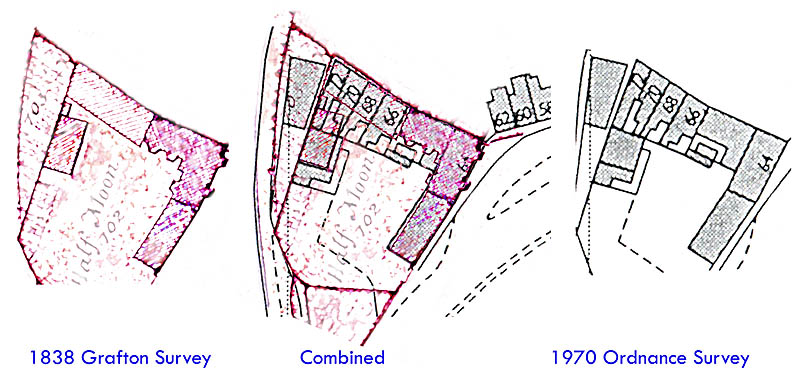
THE SUN, MOON AND STARS BUILDING

For various pictures of the Sun, Moon and Stars building please see the appropriate website section. This page aims to deal with mainly the building, providing merely an outline of its construction and its history.
In due course this building will undergo structural changes and it seems a good idea to record what we see now - mid 2007. As the project gets under way we can see how well planners and 'English Heritage' cope with the task.
|
The earliest records show a not particularly
imposing building at the site of the former Sun, Moon and Stars Inn,
this being for the year 1729. The Duke of Grafton's rent records
show that the building is his and that in 1740 a Cath Morris, too poor
to pay much rent, lives in a partially collapsed building that was once a
'publick house of some note - the Chequers Alehouse'. The woman
died in 1749 and the next news about the place is when a Mr. Thomas
Smith sells the building to John Linnett on 19 May 1797. John
Linnett rebuilt in brick using some stone walls that still stood.
He established a new
inn to take advantage of the trade relating to the canal. There
was, of course, space in the field running down to the new canal which
had been dug only two years earlier but we have no idea what outbuildings, if
any, were built there. Local lore has it, with not a
single supporting fact, that workmen dealing with the tunnel lodged
there until the tunnel was finished in 1805 and much later, a band of
registered leggers lived there. The latter assertion seems
particularly dubious. John Linnett called his new inn
the 'Half Moon Inn' and, by 1841, the place was called 'The Half Moon Yard' in
the census. |
||
 |
||
|
As mentioned above, John Linnett built in
brick in 1797. There is a date-stone displaying 'J L 1797' on the wall of the main
building which faces south. It appears to have been placed midway
between the two prominent bay-windows that are shown on the 1838 map.
It has recently become evident that the date 'stone' is not made of
stone but is instead a carefully flattened 1 inch layer of lime mortar
into which the lettering was cut with a trowel. The practice
suggests that John Linnett was not a man to waste money on such detail. The layer of mortar is becoming detached in places.
He also evidently did not waste much money on the employment of skilled
brick-layers as the work, done in Flemish bond style, is not to a high
standard. Even the choice of brick seems suspect; on the north
wall there is much seep-through of tar from chimneys that were built
onto the interior of the outside wall. This shows that the bricks
are rather porous there. If that is true for all the exterior
walling then the mortar between the course of bricks must have been
subject to some weakening by the percolation of rainwater over 200
years. |
||
|
|
||
|
Blue
lines superimposed on the image draw attention to the most obvious
re-bricking. The two light blue bars are placed with reference to
the 1838 map which shows a pair of bay windows on this wall. There
seem to be four openings that were once used. None have been re-bricked
in Flemish bond and none seem to relate to the vestiges of such large bay windows.
The vertical panel to the right might have been where a flue had been
once placed, built against the exterior wall. The date-stone is
shown centrally and seems to have been partially covered for a while by
a pitch roof (though the precise detail of that pitch is
questionable). Slightly left of centre at ground level there is a
section of wall (?) built as a block of concrete which suggests it is
either a
piece of wallplate (rustic!) placed there to stabilise a portion of the
wall or part of a loading bay for beer barrels etc. Parts of the wall have been
re-pointed and this fact
makes it appear, in a picture this small, that much has been
rebuilt. In fact the upper two storeys of brickwork appear to be
mostly the original. |
||
|
A Personal View on
Target priorities: |
||
|
1.
A successful Community project with Affordable housing, some sort
of bistro and some space for heritage presentation incorporated in the
whole. |
||